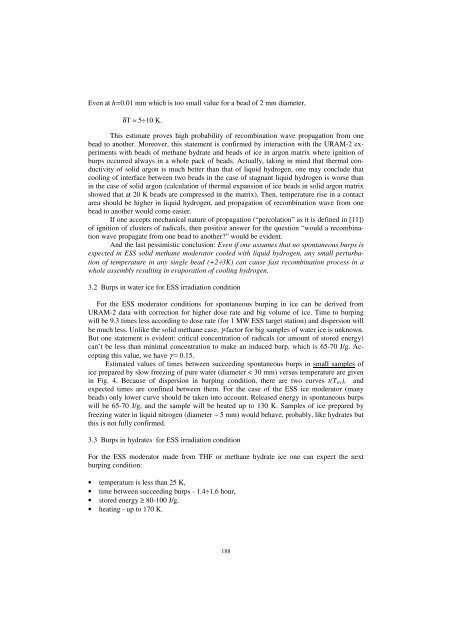Druck-Materie 20b.qxd - JUWEL - Forschungszentrum Jülich
Druck-Materie 20b.qxd - JUWEL - Forschungszentrum Jülich
Druck-Materie 20b.qxd - JUWEL - Forschungszentrum Jülich
You also want an ePaper? Increase the reach of your titles
YUMPU automatically turns print PDFs into web optimized ePapers that Google loves.
Even at h=0.01 mm which is too small value for a bead of 2 mm diameter,<br />
δT ≈ 5÷10 K.<br />
This estimate proves high probability of recombination wave propagation from one<br />
bead to another. Moreover, this statement is confirmed by interaction with the URAM-2 experiments<br />
with beads of methane hydrate and beads of ice in argon matrix where ignition of<br />
burps occurred always in a whole pack of beads. Actually, taking in mind that thermal conductivity<br />
of solid argon is much better than that of liquid hydrogen, one may conclude that<br />
cooling of interface between two beads in the case of stagnant liquid hydrogen is worse than<br />
in the case of solid argon (calculation of thermal expansion of ice beads in solid argon matrix<br />
showed that at 20 K beads are compressed in the matrix). Then, temperature rise in a contact<br />
area should be higher in liquid hydrogen, and propagation of recombination wave from one<br />
bead to another would come easier.<br />
If one accepts mechanical nature of propagation (“percolation” as it is defined in [11])<br />
of ignition of clusters of radicals, then positive answer for the question “would a recombination<br />
wave propagate from one bead to another?” would be evident.<br />
And the last pessimistic conclusion: Even if one assumes that no spontaneous burps is<br />
expected in ESS solid methane moderator cooled with liquid hydrogen, any small perturbation<br />
of temperature in any single bead (+2÷3K) can cause fast recombination process in a<br />
whole assembly resulting in evaporation of cooling hydrogen.<br />
3.2 Burps in water ice for ESS irradiation condition<br />
For the ESS moderator conditions for spontaneous burping in ice can be derived from<br />
URAM-2 data with correction for higher dose rate and big volume of ice. Time to burping<br />
will be 9.3 times less according to dose rate (for 1 MW ESS target station) and dispersion will<br />
be much less. Unlike the solid methane case, γ-factor for big samples of water ice is unknown.<br />
But one statement is evident: critical concentration of radicals (or amount of stored energy)<br />
can’t be less than minimal concentration to make an induced burp, which is 65-70 J/g. Accepting<br />
this value, we have γ ≈ 0.15.<br />
Estimated values of times between succeeding spontaneous burps in small samples of<br />
ice prepared by slow freezing of pure water (diameter < 30 mm) versus temperature are given<br />
in Fig. 4. Because of dispersion in burping condition, there are two curves t(Tirr), and<br />
expected times are confined between them. For the case of the ESS ice moderator (many<br />
beads) only lower curve should be taken into account. Released energy in spontaneous burps<br />
will be 65-70 J/g, and the sample will be heated up to 130 K. Samples of ice prepared by<br />
freezing water in liquid nitrogen (diameter ∼ 5 mm) would behave, probably, like hydrates but<br />
this is not fully confirmed.<br />
3.3 Burps in hydrates for ESS irradiation condition<br />
For the ESS moderator made from THF or methane hydrate ice one can expect the next<br />
burping condition:<br />
• temperature is less than 25 K,<br />
• time between succeeding burps - 1.4÷1.6 hour,<br />
• stored energy ≥ 80-100 J/g,<br />
• heating - up to 170 K.<br />
188

















